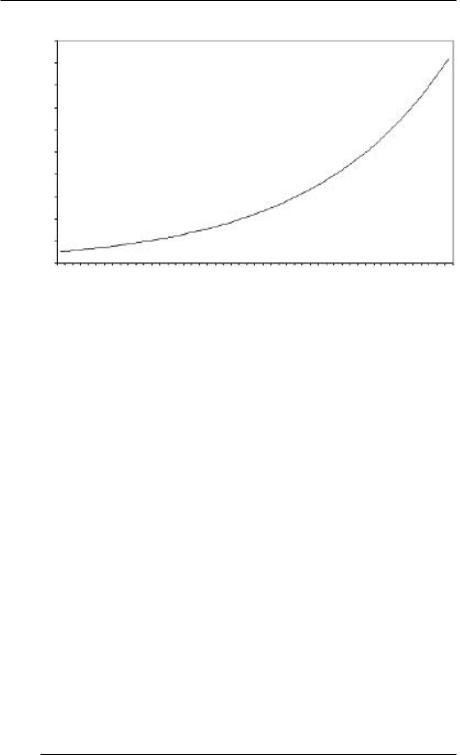
Brown Web of Debt The Shocking Truth about our Money System (3rd ed)
.pdf
Chapter 2 - Behind the Curtain
“Liquid” instruments are those that are easily convertible into cash. The American money supply is officially divided into M1, M2, and M3. Only M1 is what we usually think of as money – coins, dollar bills, and the money in our checking accounts. M2 is M1 plus savings accounts, money market funds, and other individual or “small” time deposits. (The “money market” is the trade in short-term, low-risk securities, such as certificates of deposit and U.S. Treasury notes.) M3 is M1 and M2 plus institutional and other larger time deposits (including institutional money market funds) and eurodollars (American dollars circulating abroad).
In 2005, M1 (coins, dollar bills and checking account deposits) tallied in at $1.4 trillion. Federal Reserve Notes in circulation came to $758 billion, but about 70 percent of those circulated overseas, bringing the figure down to $227.5 billion in use in the United States.7 The U.S. Mint reported that in September 2004, circulating collections of coins came to only $993 million, or just under $1 billion.8 M3 (the largest measure of the money supply) was $9.7 trillion in 2005.9 Thus coins made up only about one one-thousandth of the total money supply (M3), and tangible currency in the form of coins and Federal Reserves Notes (dollar bills) together made up only about 2.4 percent of it. The other 97.6 percent magically appeared from somewhere else. This was the money Wright Patman said was created by banks when they made loans.
The mechanics of money creation were explained in a revealing booklet published by the Chicago Federal Reserve in the 1960s, called “Modern Money Mechanics: A Workbook on Bank Reserves and Deposit Expansion.”10 The booklet is a gold mine of insider information and will be explored at length later, but here are some highlights. It begins, “The purpose of this booklet is to describe the basic process of money creation in a ‘fractional reserve’ banking system. . . . The actual process of money creation takes place primarily in banks.” The Chicago Fed then explains:
[Banks] do not really pay out loans from the money they receive as deposits. If they did this, no additional money would be created. What they do when they make loans is to accept promissory notes in exchange for credits to the borrowers’ transaction
accounts.
The booklet explains that money creation is done by “building up” deposits, and that this is done by making loans. Contrary to popular belief, loans become deposits rather than the reverse. The Chicago Fed states:
26

Web of Debt
[B]anks can build up deposits by increasing loans and investments so long as they keep enough currency on hand to redeem whatever amounts the holders of deposits want to convert into currency. This unique attribute of the banking business was discovered many centuries ago. It started with goldsmiths . . . .
The “unique attribute” discovered by the goldsmiths was that they could issue and lend paper receipts for the same gold many times over, so long as they kept enough gold in “reserve” for any depositors who might come for their money. This was the sleight of hand later dignified as “fractional reserve” banking . . . .
The Shell Game of the Goldsmiths Becomes
“Fractional Reserve” Banking
Trade in seventeenth century Europe was conducted primarily with gold and silver coins. Coins were durable and had value in themselves, but they were hard to transport in bulk and could be stolen if not kept under lock and key. Many people therefore deposited their coins with the goldsmiths, who had the strongest safes in town. The goldsmiths issued convenient paper receipts that could be traded in place of the bulkier coins they represented. These receipts were also used when people who needed coins came to the goldsmiths for loans.
The mischief began when the goldsmiths noticed that only about 10 to 20 percent of their receipts came back to be redeemed in gold at any one time. They could safely “lend” the gold in their strongboxes at interest several times over, as long as they kept 10 to 20 percent of the value of their outstanding loans in gold to meet the demand. They thus created “paper money” (receipts for loans of gold) worth several times the gold they actually held. They typically issued notes and made loans in amounts that were four to five times their actual supply of gold. At an interest rate of 20 percent, the same gold lent five times over produced a 100 percent return every year – this on gold the goldsmiths did not actually own and could not legally lend at all! If they were careful not to overextend this “credit,” the goldsmiths could thus become quite wealthy without producing anything of value themselves. Since more money was owed back than the townspeople as a whole possessed, the wealth of the town and eventually of the country was siphoned into the vaults of these goldsmiths-turned-bankers, while the people fell progressively into their debt.11
27

Chapter 2 - Behind the Curtain
If a landlord had rented the same house to five people at one time and pocketed the money, he would quickly have been jailed for fraud. But the goldsmiths had devised a system in which they traded, not things of value, but paper receipts for them. The system was called “fractional reserve” banking because the gold held in reserve was a mere fraction of the banknotes it supported. In 1934, Elgin Groseclose, Director of the Institute for International Monetary Research, wryly observed:
A warehouseman, taking goods deposited with him and devoting them to his own profit, either by use or by loan to another, is guilty of a tort, a conversion of goods for which he is liable in civil, if not in criminal, law. By a casuistry which is now elevated into an economic principle, but which has no defenders outside the realm of banking, a warehouseman who deals in money is subject to a diviner law: the banker is free to use for his private interest and profit the money left in trust. . . . He may even go further. He may create fictitious deposits on his books, which shall rank equally and ratably with actual deposits in any division of assets in case of liquidation.12
A tort is a wrongdoing for which a civil action may be brought for damages. Conversion is a tort involving the treatment of another’s property as one’s own. Another tort that has been applied to this sleight of hand is fraud, defined in Black’s Law Dictionary as “a false representation of a matter of fact, whether by words or by conduct, by false or misleading allegations, or by concealment of that which should have been disclosed, which deceives and is intended to deceive another so that he shall act upon it to his legal injury.” That term was used by the court in a landmark Minnesota lawsuit in 1969 . . . .
Taking It to Court
First National Bank of Montgomery vs. Daly was a courtroom drama worthy of a movie script. Defendant Jerome Daly opposed the bank’s foreclosure on his $14,000 home mortgage loan on the ground that there was no consideration for the loan. “Consideration” (“the thing exchanged”) is an essential element of a contract. Daly, an attorney representing himself, argued that the bank had put up no real money for his loan.
The courtroom proceedings were recorded by Associate Justice Bill Drexler, whose chief role, he said, was to keep order in a highly charged
28

Web of Debt
courtroom where the attorneys were threatening a fist fight. Drexler hadn’t given much credence to the theory of the defense, until Mr. Morgan, the bank’s president, took the stand. To everyone’s surprise, Morgan admitted that the bank routinely created the money it lent “out of thin air,” and that this was standard banking practice.
“It sounds like fraud to me,” intoned Presiding Justice Martin Mahoney amid nods from the jurors. In his court memorandum, Justice Mahoney stated:
Plaintiff admitted that it, in combination with the Federal Reserve Bank of Minneapolis, . . . did create the entire $14,000.00 in money and credit upon its own books by bookkeeping entry. That this was the consideration used to support the Note dated May 8, 1964 and the Mortgage of the same date. The money and credit first came into existence when they created it. Mr. Morgan admitted that no United States Law or Statute existed which gave him the right to do this. A lawful consideration must exist and be tendered to support the Note.
The court rejected the bank’s claim for foreclosure, and the defendant kept his house. To Daly, the implications were enormous. If bankers were indeed extending credit without consideration – without backing their loans with money they actually had in their vaults and were entitled to lend – a decision declaring their loans void could topple the power base of the world. He wrote in a local news article:
This decision, which is legally sound, has the effect of declaring all private mortgages on real and personal property, and all U.S. and State bonds held by the Federal Reserve, National and State banks to be null and void. This amounts to an emancipation of this Nation from personal, national and state debt purportedly owed to this banking system. Every American owes it to himself
. . . to study this decision very carefully . . . for upon it hangs the question of freedom or slavery.13
Needless to say, however, the decision failed to change prevailing practice, although it was never overruled. It was heard in a Justice of the Peace Court, an autonomous court system dating back to those frontier days when defendants had trouble traveling to big cities to respond to summonses. In that system (which has now largely been phased out), judges and courts were pretty much on their own. Justice Mahoney went so far as to threaten to prosecute and expose the bank. He died less than six months after the Daly trial, in a mysterious accident that appeared to involve poisoning.14
29

Chapter 2 - Behind the Curtain
Since that time, a number of defendants have attempted to avoid loan defaults using the defense Daly raised; but they have met with only limited success. As one judge said off the record, using a familiar Wizard of Oz metaphor:
If I let you do that – you and everyone else – it would bring the whole system down. . . . I cannot let you go behind the bar of the bank. . . . We are not going behind that curtain!15
In an informative website called Money: What It Is, How It Works, William Hummel states that banks today account for only about 20 percent of total credit market debt. The rest is advanced by non-bank financial institutions, including finance companies, pension funds, mutual funds, insurance companies, and securities dealers. These institutions merely recycle pre-existing funds, either by borrowing at a low interest rate and lending at a higher rate or by pooling the money of investors and lending it to borrowers. In other words, they do what most people think banks do: they borrow low and lend high, pocketing the “spread” as their profit. What banks actually do, however, is something quite different. Hummel explains:
Banks are not ordinary intermediaries. Like non-banks, they also borrow, but they do not lend the deposits they acquire. They lend by crediting the borrower’s account with a new deposit . . . . The accounts of other depositors remain intact and their deposits fully available for withdrawal. Thus a bank loan increases the total of bank deposits, which means an increase in the money supply.16
If the money supply is being increased, money is being created by sleight of hand. What Elgin Groseclose called the “diviner law” of the bankers allows them to magically pull money out of an empty hat.
The “Impossible Contract”
There are other legal grounds on which the bankers’ fractional reserve loans might be challenged besides failure of consideration and fraud. In theory, at least, these loan contracts could be challenged because they are collectively impossible to perform. Under state civil codes, a contract that is impossible to perform is void.17 The impossibility in this case arises because the banks create the principal but not the interest needed to pay back their loans. The debtors scramble to find the interest somewhere else, but there is never enough money to go around. Like in a grand game of musical chairs, when the music stops, somebody has to default. In an 1850 treatise called
30

Web of Debt
The Importance of Usury Laws, a writer named John Whipple did the math. He wrote:
If 5 English pennies . . . had been [lent] at 5 per cent compound interest from the beginning of the Christian era until the present time (say 1850), it would amount in gold of standard fineness to 32,366,648,157 spheres of gold each eight thousand miles in diameter, or as large as the earth.18
Thirty-two billion earth-sized spheres! Such is the nature of compound interest -- interest calculated not only on the initial principal but on the accumulated interest of prior payment periods. The interest “compounds” in a parabolic curve that is virtually flat at first but goes nearly vertical after 100 years. Debts don’t usually grow to these extremes because most loans are for 30 years or less, when the curve remains relatively flat. But the premise still applies: in a system in which money comes into existence only by borrowing at interest, the system as a whole is always short of funds, and somebody has to default.
Bernard Lietaer helped design the single currency system (the Euro) and has written several books on monetary reform. He explains the interest problem like this:
When a bank provides you with a $100,000 mortgage, it creates only the principal, which you spend and which then circulates in the economy. The bank expects you to pay back $200,000 over the next 20 years, but it doesn’t create the second $100,000
— the interest. Instead, the bank sends you out into the tough world to battle against everybody else to bring back the second $100,000.
The problem is that all money except coins now comes from bankercreated loans, so the only way to get the interest owed on old loans is to take out new loans, continually inflating the money supply; either that, or some borrowers have to default. Lietaer concluded:
[G]reed and competition are not a result of immutable human temperament . . . . [G]reed and fear of scarcity are in fact being continuously created and amplified as a direct result of the kind of money we are using. . . . [W]e can produce more than enough food to feed everybody, and there is definitely enough work for everybody in the world, but there is clearly not enough money to pay for it all. The scarcity is in our national currencies. In fact, the job of central banks is to create and maintain that currency scarcity. The direct consequence is that we have to fight with each other in order to survive.19
31

Chapter 2 - Behind the Curtain
$10,000 lent at 6% interest compounded annually
$200,000
$180,000 Adapted from: www.buyupside.com $160,000
$140,000 $120,000 $100,000 $80,000 $60,000 $40,000 $20,000
0 1 3 5 7 9 11 13 15 17 19 21 23 25 27 29 31 33 35 37 39 41 43 45 47 49 Years Held
A dollar lent at 6 percent interest, compounded annually, becomes ten dollars in less than 40 years. That means that if the money supply were 100 percent gold, and if banks lent 10 percent of it at 6 percent interest compounded annually (continually rolling principal and interest over into more loans), in 40 years the bankers would own all the gold. It also means that the inflation everyone complains about is actually necessary to keep the scheme going. To keep workers on the treadmill that powers their industrial empire, the financiers must create enough new debt-money to cover the interest on their loans. They don’t want to create too much, as that would dilute the value of their own share of the pie; but in a “credit crisis” such as we are facing today, the central banks can and do flood the market with money created with accounting entries. In a single day in August 2007, the U.S. Federal Reserve “injected” $38 billion into the financial markets to rescue troubled banks and investment firms. Where did this money come from? It was just an advance of “credit,” something central banks claim the right to do as “lenders of last resort.” These advances can be rolled over or renewed indefinitely, creating a stealth inflation that drives up prices at the pump and the grocery store.20 (More on this later.)
32

Web of Debt
The Money Supply and the Federal Debt
To keep the economic treadmill turning, not only must the money supply continually inflate but the federal debt must continually expand. The reason was revealed by Marriner Eccles, Governor of the Federal Reserve Board, in hearings before the House Committee on Banking and Currency in 1941. Wright Patman asked Eccles how the Federal Reserve got the money to buy government bonds.
“We created it,” Eccles replied. “Out of what?”
“Out of the right to issue credit money.”
“And there is nothing behind it, is there, except our government’s credit?”
“That is what our money system is,” Eccles replied. “If there were no debts in our money system, there wouldn’t be any money.”21
That explains why the federal debt never gets paid off but just continues to grow. The federal debt hasn’t been paid off since the presidency of Andrew Jackson nearly two centuries ago. Rather, in all but five fiscal years since 1961 (1969 and 1998 through 2001), the government has exceeded its projected budget, adding to the national debt.22 Economist John Kenneth Galbraith wrote in 1975:
In numerous years following the [civil] war, the Federal Government ran a heavy surplus. [But] it could not pay off its debt, retire its securities, because to do so meant there would be no bonds to back the national bank notes. To pay off the debt was to destroy the money supply.23
The federal debt has been the basis of the U.S. money supply ever since the Civil War, when the National Banking Act authorized private banks to issue their own banknotes backed by government bonds deposited with the U.S. Treasury. (This complicated bit of chicanery is explored in Chapter 9.) When President Clinton announced “the largest budget surplus in history” in 2000, and President Bush predicted a $5.6 trillion surplus by the end of the decade, many people got the impression that the federal debt had been paid off; but this was another illusion. Not only did the $5.6 trillion budget “surplus” never materialize (it was just an optimistic estimate projected over a ten-year period based on an anticipated surplus for the year 2001 that never materialized), but it entirely ignored the principal owing on the federal debt. Like the deluded consumer who makes the minimum monthly interest payment on his credit card bill and calls his credit
33

Chapter 2 - Behind the Curtain
limit “cash on hand,” politicians who speak of “balancing the budget” include in their calculations only the interest on the national debt. By 2000, when President Clinton announced the largest-ever budget surplus, the federal debt had actually topped $5 trillion; and by October 2005, when the largest-ever projected surplus had turned into the largest-ever budget deficit, the federal debt had mushroomed to $8 trillion. M3 was $9.7 trillion the same year, not much more. It is hardly an exaggeration to say that the money supply is the federal debt and cannot exist without it. Commercial loans alone cannot sustain the money supply because they zero out when they get paid back. In order to keep money in the system, some major player has to incur substantial debt that never gets paid back; and this role is played by the federal government.
That is one reason the federal debt can’t be paid off, but today there is an even more compelling reason: the debt has simply grown too large. To get some sense of the magnitude of an 8-plus trillion dollar debt, if you took 7 trillion steps you could walk to the planet Pluto, which is a mere 4 billion miles away.24 If the government were to pay $100 every second, in 317 years it would have paid off only one trillion dollars of debt. And that’s just for the principal. If interest were added at the rate of only 1 percent compounded annually, the debt could never be paid off in this way, because the debt would grow faster than it was being repaid.25 Paying an $8-plus trillion debt off in a lump sum through taxation, on the other hand, would require increasing the tax bill by more than $100,000 for every family of four, a non-starter for most families.26
In the 1980s, policymakers openly declared that “deficits don’t matter.” The government could engage in “deficit spending” and simply allow the debt to grow. This policy continues to be cited with approval by policymakers today.27 The truth is that nobody even expects the debt to be paid off, because it can’t be paid off – at least, it can’t while money is created as a debt to private banks. The government doesn’t have to pay the principal so long as it keeps “servicing” the debt by paying the interest. But according to David M. Walker, Director of the U.S. General Accounting Office and Comptroller General of the United States, just the interest tab will soon be more than the taxpayers can afford to pay. When the government can’t pay the interest, it will have to renege on the debt, and the economy will collapse.28
How did we get into this witches’ cauldron, and how can we get out of it? The utopian vision of the early American colonists involved a money system that was quite different from what we have today. To understand what we lost and how we lost it, we’ll take a journey back down the Yellow Brick Road to eighteenth century America.
34

Web of Debt
Chapter 3
EXPERIMENTS IN UTOPIA:
COLONIAL PAPER MONEY
AS LEGAL TENDER
Dorothy and her friends were at first dazzled by the brilliancy of the wonderful City. The streets were lined with beautiful houses all built of green marble and studded everywhere with sparkling emeralds. They walked over a pavement of the same green marble, and where the blocks were joined together were rows of emeralds, set closely, and glittering in the brightness of the sun. . . . Everyone seemed happy and contented and prosperous.
– The Wonderful Wizard of Oz,
“The Emerald City of Oz”
Frank Baum’s vision of a magical city shimmering in the sun captured the utopian American dream. Walt Disney would later pick up the vision with his castles in the clouds, the happily-
ever-after endings to romantic Hollywood fairytales. Baum, who was Irish, may have been thinking of the Emerald Isle, the sacred land of Ireland. The Emerald City also suggested the millennial visions of the Biblical New Jerusalem and the “New Atlantis,” the name Sir Francis Bacon gave to the New World.
The American colonies were an experiment in utopia. In an uncharted territory, you could design new systems and make new rules. Paper money was already in use in England, but it had fallen into the hands of private bankers who were using it for private profit at the expense of the people. In the American version of this new medium of exchange, paper money was issued and lent by provincial governments, and the proceeds were used for the benefit of the people. The colonists’ new paper money financed a period of prosperity that was considered remarkable for isolated colonies lacking their own
35
